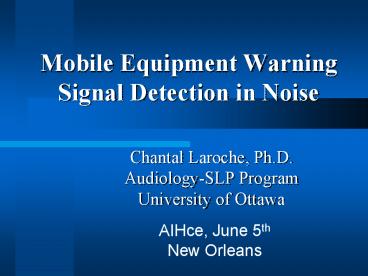Mobile Equipment Warning Signal Detection in Noise - PowerPoint PPT Presentation
1 / 20
Title:
Mobile Equipment Warning Signal Detection in Noise
Description:
dump truck. reverse alarm not detected. alarm in front of the ... dump truck. Absence of reverse alarm? Noise from a mechanical digger ... – PowerPoint PPT presentation
Number of Views:108
Avg rating:3.0/5.0
Title: Mobile Equipment Warning Signal Detection in Noise
1
Mobile Equipment Warning Signal Detection in Noise
- Chantal Laroche, Ph.D.
- Audiology-SLP Program
- University of Ottawa
AIHce, June 5th New Orleans
2
PROBLEM
- Each year, serious accidents occur in noisy
workplaces because a warning sound is not heard. - The bad perception of reverse alarms on mobile
vehicles (e.g. dump trucks, forklifts) is one
element which can explain some of the accidents. - Potential causes high levels of ambiant noise,
noise-induced hearing loss, lack of attention,
placement and acoustic features of alarms,
hearing protectors
3
SOME STATISTICS
- Fatal accidents involving workers struck by a
machine in motion - - 1980-1992 667 fatal accidents (USA)
- (on construction sites Sweeney et al., 1999)
- - 1975-2000 25 fatal accidents (Quebec)
- (in reverse mode Laroche, 2001)
4
SOME STATISTICS
- Serious or fatal accidents involving
- forklifts
- 1984-1992 14 deaths (Illinois)
- 1991-1992 24 deaths (OSHA)
- 1994-1997 316 serious accidents
- (CSST, Quebec)
- 1974-1999 9 deaths (CSST, Quebec)
5
Examples of accidents involving mobile vehicles
6
Examples of accidents involving forklifts
7
POTENTIAL CAUSES
- High level of ambiant noise in the workplace
- High prevalence of noise-induced hearing loss
(NIHL) - Workers attentional demand
- Inadequate placement of reverse alarms on
vehicles - Deficient acoustic features of existing reverse
alarms - Hearing protectors
8
High levels of ambiant noise
- On construction sites (Suter, 1999)
- 745 000 (out of 5 million) workers exposed to
Lp 85 dBA - Inadequate signal to noise ratio
9
PREVALENCE OF NIHL
- On construction sites
- 18 to 33 of workers have
- hearing thresholds
- greater than an average of 25 dB
- at 1, 2, and 3 kHz
- (Ohlin, 1999)
10
Worker s attention demand and perception
- Wilcox (1994) has discussed myths associated
with the perception of reverse alarms and the
attention demand on forklift trucks - Pedestrians get used to reverse alarms
(habituation phenomenon) - Many forklifts, each equipped with an alarm,
would create confusion
11
Workers attention demand and perception
- Accidents are caused by a task that demands too
much of the victims attention - Reverse alarms are annoying
12
Inadequate placement of reverse alarms
- SAE-J994 standard on reverse alarms
- The alarm should be tested in free field, 4
feet above a horizontal reflecting plane, with
the microphone 4 feet from the alarms horn along
its 0 degree axis . - This standard does not insure that every worker
will perceive the alarm at any position behind
the vehicle.
13
Deficient acoustic features
- What is found on the market?
- Reverse alarms with a pure tone (1000-1300 Hz)
or modulated tones between two approximate
frequencies (e.g. 1272-1310 Hz)
14
Axis positions behind the heavy vehicles
15
Positions of the alarm on a grader
16
Variations in sound pressure levels at the rear
of a grader
17
Sound wave reflections
18
Hearing protection
- Sense of insecurity frequently reported
- Difficulty to hear and understand
- speech communication
- and warning signals
19
Recommendations
- In order to reduce the number of fatal accidents
involving pedestrians at the rear of vehicles - Modifications in the design and positioning of
reverse alarms - Avoid pure tones
- Optimize the position
- Better ergonomic design of mobile equipment
- Addition of pedestrian corridors, when possible
20
Recommendations (contd)
- Explore ways to limit the habituation phenomenon
- Obstacle detectors
- Use of electronic mirrors
- There is a need for improvement in the
reliability of these devices - Noise reduction in the workplace
- Would reduce the prevalence of NIHL
- Would reduce the masking effect of the background
noise































